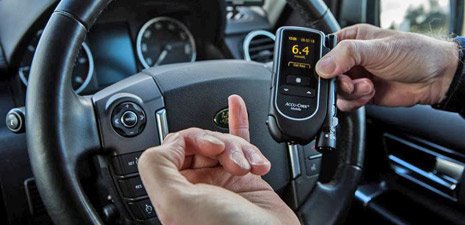The recent news that alcohol was not a factor in Tiger Woods’ DUI Arrest sheds light on the false symptoms and breathalyzer readings associated with diabetes.
Do you know that someone with diabetes can arrested for drunk driving because they’re experiencing an unexpected low blood sugar level?
The similarity in symptoms caused by alcohol intoxication and low blood glucose levels commonly leads to easy—but false—conclusions by law enforcement officers.
Breath-alcohol machines use infrared beams of light. The light beams are absorbed by any chemical compound in the breath sample (including ethyl alcohol) that contains the “methyl group” in its molecular structure. The more absorption, the higher the blood-alcohol reading. The machine is programmed to assume that the compound is “probably” alcohol.
Unfortunately, thousands of compounds containing the methyl group can register as alcohol. One of these is acetone. And a well-documented byproduct of hyperglycemia is a state called ketoacidosis, which causes the production of acetones in the breath. In other words, the Breathalyzer will read significant levels of alcohol on a person with diabetes’ breath, where in fact there may be little or none at all.
In America fifteen to 20 percent of all drivers on the road are living with diabetes. The reactions of a person in the early stages of a low blood glucose attack include dizziness, blurred vision, slurred speech, weakness, loss of coordination and confusion. Coincidentally, these are the symptoms and signs that the patrol officer is looking for in a person who is driving under the influence of alcohol. And the officer’s observations are quickly followed by a failing performance on DUI field sobriety tests.
The police report indicated that Tiger Woods was found asleep in his car while it was running. An alcohol breathalyzer test showed Woods had a blood alcohol level of 0.00, but his arrest report indicates he was taking four prescription medications at various points in the past few years, most of which are typically prescribed for pain.
Over the course of his career, Tiger Woods likely struggled with pain. He not only injured his knees, legs, and back playing golf, but also underwent multiple surgeries for those injuries and crashed a car. According to the Centers for Disease Control and Prevention, more than a third of people who undergo surgery get an opioid prescription.
Undoubtedly, thousands of people with diabetes have been falsely accused—and convicted—of drunk driving in the past because of nothing more than a physiological condition.
The American Diabetes Association recommends these tips for people with diabetes to ensure they are safe behind the wheel:
- Always check your blood glucose before you get behind the wheel and at regular intervals during long drives.
- Always carry your blood glucose meter and plenty of snacks — including a quick-acting source of sugar — with you when you drive.
- Pull over as soon as you feel any of the signs of low blood glucose (hypoglycemia), and check your blood glucose level.
- If your blood glucose is low, eat a snack that contains a fast-acting sugar source such as juice, non-diet soda, hard candy, or glucose tablets. Wait 15 minutes and check your blood glucose again to make sure it’s at your target range before you resume driving.
- If you experience hypoglycemia unawareness, stop driving and consult your health care provider. Do not resume driving until awareness has been reestablished.
- Get regular eye exams for early detection of diabetes-related vision problems that can affect your driving ability.
For more information on safe driving, see the brochure “Driving When You Have Diabetes” created by the National Highway Traffic Safety Administration and the American Diabetes Association.
LISTEN NOW: Enjoy an exciting mix of pop culture, diabetes information and advice along with music by today’s hottest artists on Divabetic’s free monthly podcast, Diabetes Late Nite. In June we’re talking about Diabetic Macular Edema (DME) with music by Maxwell. Guests include singer Alfa Anderson, Diabetic Macular Edema patient Maryanne Kass, Artist Bryce Chisholm, the Charlie’s Angels of Outreach, Poet Lorraine Brooks and Mama Rose Marie. Throughout the podcast we will be featuring selected songs from several of several of Maxwell’s albums courtesy of SONY Music





